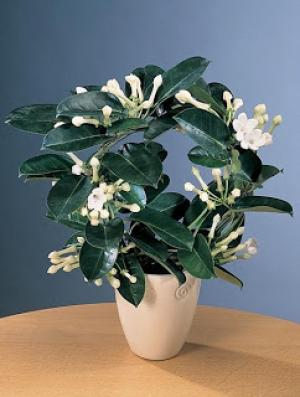You can propagate Madagascar Jasmine from cuttings or seeds
Many cultures revere ancestors, but in Madagascar, you are not dead until your body has totally disappeared from earth. Although the dead are often buried high up in caves so they are that much closer to heaven, their spirits do not move to heaven until their bodies have completely decomposed. That means their spirits can still talk to the living. Corpses are plucked from the tomb, dressed up, and danced with.
Madagascar gives us a plant that also seems to defy death, Stephanotis floribunda, a climbing, woody-stemmed plant that blooms with heavenly fragrant clusters of tubular white flowers.
That deep fragrance gives the plant its common nickname of Madagascar Jasmine, but this is really a type of milkweed with the same milky sap as other members of the family, Asclepiadaceae.
For best results, place Stephanotis where it gets plenty of light, in a sunny room or window. In the summer, be careful it doesn't get scorched by too much direct sunlight.
It does well in most home environments and takes well to cooler rooms with winter temperatures around 55-60ºF. It can even survive slightly cooler rooms down to around 50ºF.
Since these plants need high humidity, set the pot on a tray of gravel filled with water, keeping the water level so it doesn't touch the bottom of the pot. You can also increase humidity with daily misting of water, best in the morning so the plant doesn't go to bed wet.
Since plants usually show very little growth during winter, cut back a bit on watering them. Let the soil get dry to the touch between waterings. Never let the soil dry completely. When plants are actively growing in spring and early summer, increase watering. You can feed your Madagascar Jasmine every few weeks during the spring and summer, using a houseplant fertilizer that is high in potassium.
These tropical plants grow best in rich potting soil that drains easily. You may have to repot every three or four years, moving the plant to a pot just one size larger. Many gardeners train the vines onto a hoop or a ring. Insert the trellis or hoop while the plant is young so you do not damage any roots.
Stephanotis needs very little pruning, so just cut out any weak or dead branches, best done in midwinter. Never cut back too much, or you may kill the plant.
You can propagate Madagascar Jasmine from cuttings or seeds. Take four- or five-inch cuttings that have at least two leaf nodes. Nodes are the bumps on stems that usually develop into a leaf. It is best to use cuttings from shoots that have not flowered. Dip the cuttings into a rooting hormone and plant them in pots filled with potting soil mixed with sand.
Place the cuttings in a warm spot, preferably with a heat pad underneath. To keep in humidity, loosely fit a plastic bag over the cuttings. The cuttings should root in four to six weeks and be ready to transplant into small pots.
To grow from seed, you can hope your plant produces fruit or get seeds from online merchants. Plant the seeds in potting soil and keep the pots relatively warm. Again, a heating pad can help.
With a little care, your Madagascar Jasmine will bloom with one of the nicest fragrances in the plant world. These waxy white flowers have long been a favorite in wedding bouquets, and in tribute to its Madagascar home you just may want to expand the guest list to include deceased ancestors and friends.
Just don't wait for an RSVP, unless you have a Ouija board.




















































